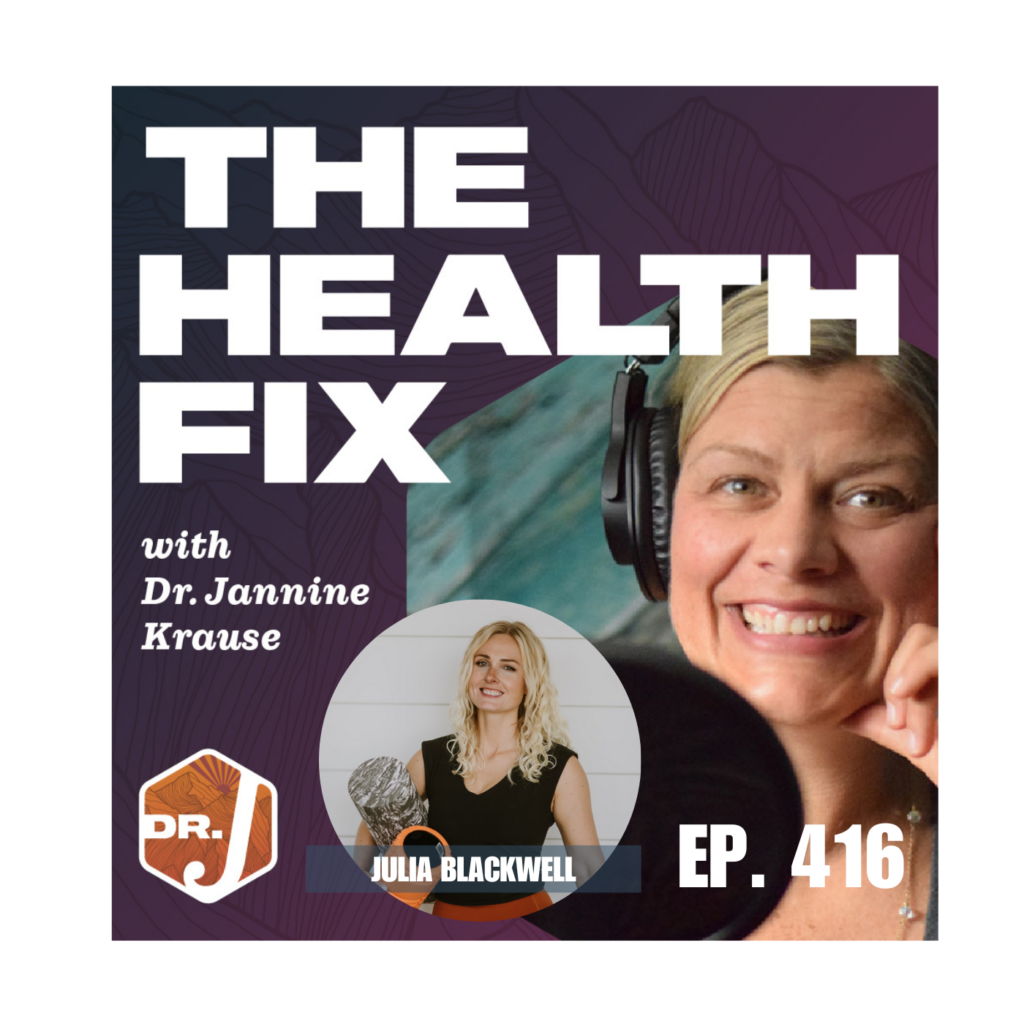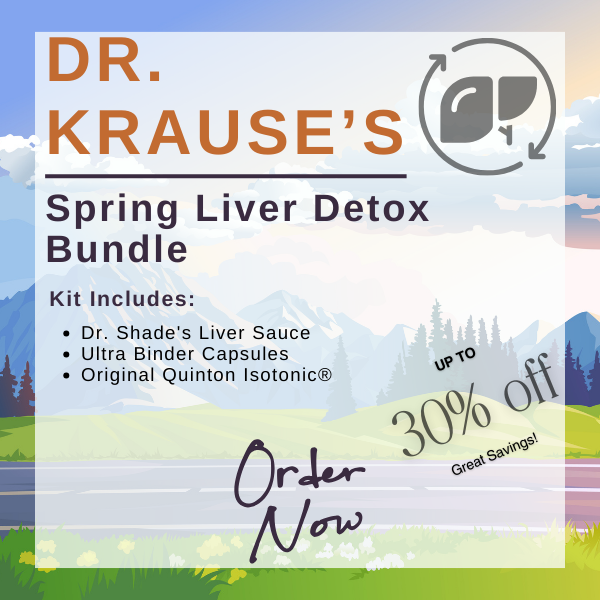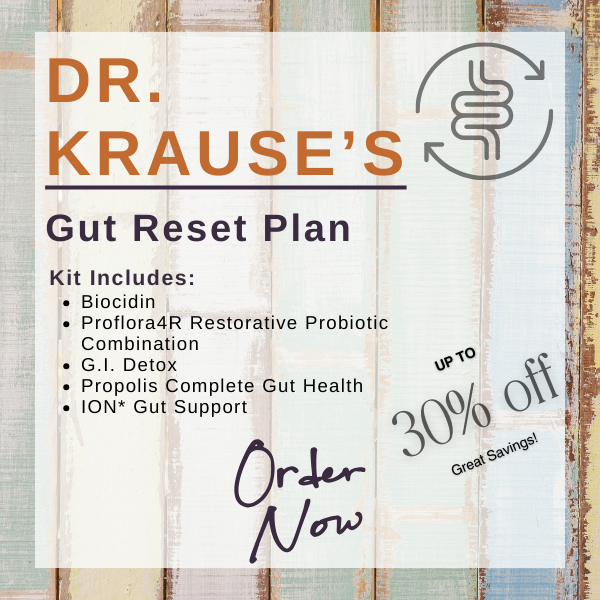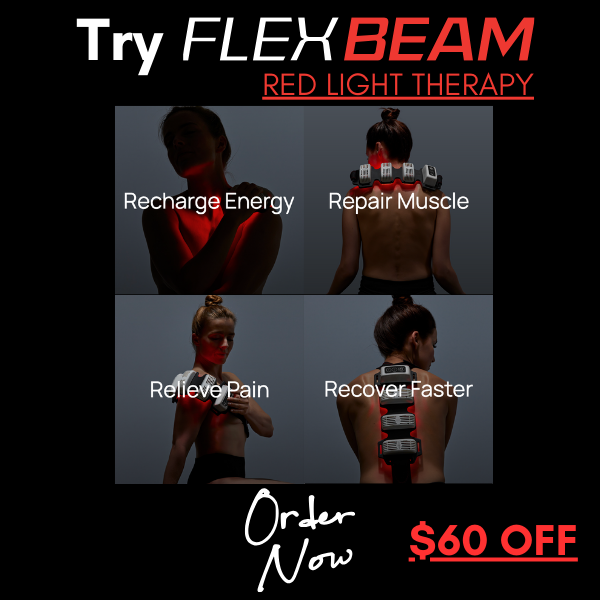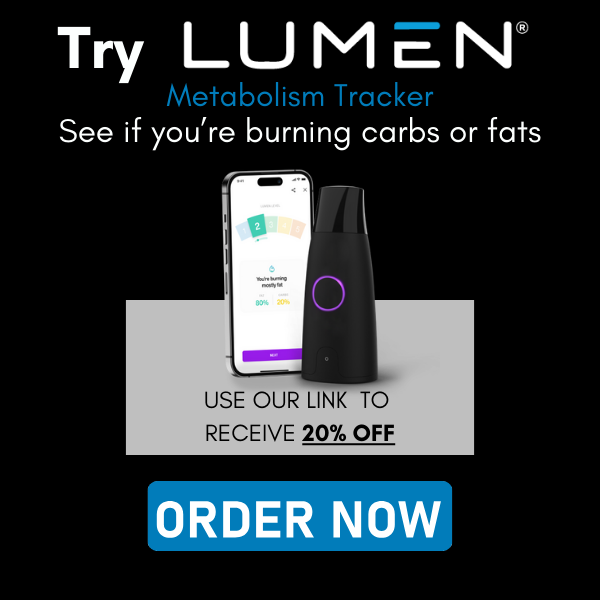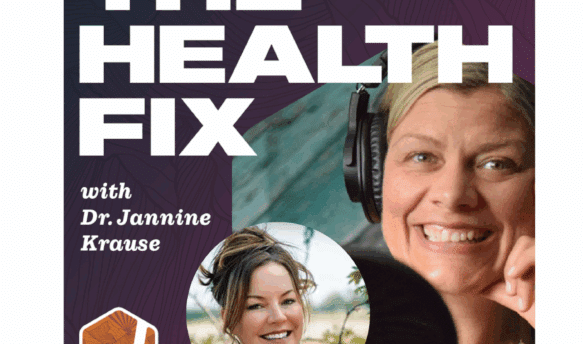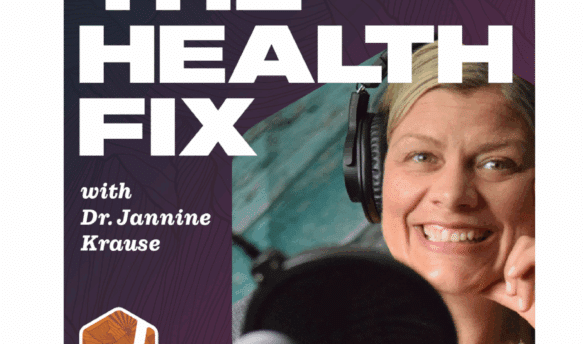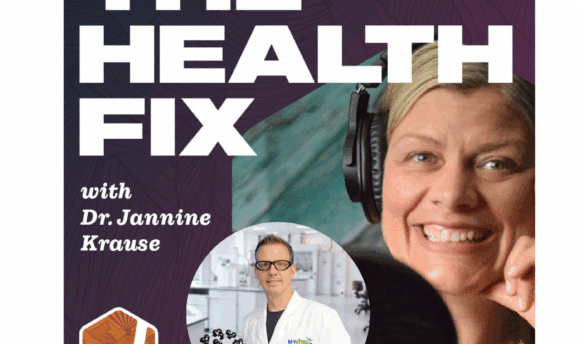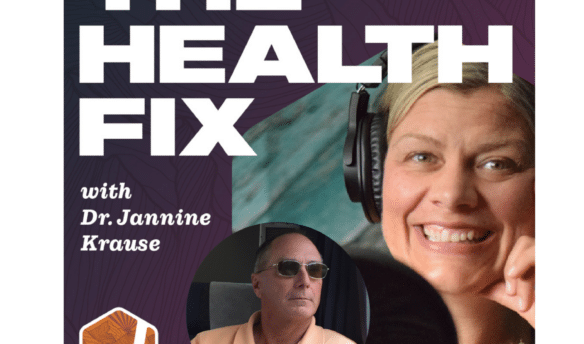Your structural integrity, strength and power is based on the health of your fascial tissue. When it’s not hydrated or mobile it has the potential to lock you into a cycle of chronic pain and reduced mobility. Julia Blackwell became a facial therapist after years of being told her shoulder condition from birth would never improve and feeling no lasting relief from any treatments, she was introduced to a unique type of fascia release bodywork. In just 3 months of this fascia specific work, she saw more improvement in the feel and function of her arm than she had in 16 years of traditional treatments! This experience catapulted Julia into learning everything she could about fascia, the critical roles it plays in our movement and overall health, and how to restore it. After learning multiple modalities and working with clients for 12 years, she formulated her own approach for bodywork & foam rolling work called The Fascia Remedy. In this episode of The Health Fix Podcast, Dr. Jannine Krause interviews Julia Blackwell on how to take care of your fascial tissue to optimize your health and longevity.
Dr. Krause’s Protocols
Instructions Included
Traveling soon? Looking to detox or reset your gut? Try one of Dr. Krause’s Fullscript plans.
What You’ll Learn In This Episode:
- Why fascia is your protector tissue
- How you can be well hydrated but still have trouble getting water in restricted fascia
- Why plantar fasciitis is due to lack of hydration and circulation to the feet
- How structural pain issue are often tight fascia
- Why compression, cross fiber and active movements release facia the best
Resources From The Show:
- Movement by Julia – Julia’s Website
- Roller Remedy – Julia’s comprehensive fascial roller release course
Our Partners
Podcast Transcript
JANNINE: [Intro] Welcome to the Health Fix Podcast where health junkies get their weekly fix of tips, tools and techniques to have limitless energy, sharp minds and fit physics or life. Hey health junkies, on this episode of the Health Fix Podcast, I’m interviewing Julia Blackwell. Julia was born a severe nerve damage to her right shoulder and grew up going to doctor after doctor to figure out what was going on but also to help her condition. Not finding any lasting relief at all from treatment after treatment became quite frustrating for her. But then she was introduced to a unique type of fascia release bodywork. And after three months of this work, she saw tons of improvement and felt amazing. And so of course, she decided she had to teach others about this and dedicate her life to it. And so in this podcast, I’m going to be talking to Julia about fascia, what it is, how it works, how it can be involved in trauma but not only that chronic pain. And we go through a great podcast here in conversation all about fascia and how working with it can release your pain, your trauma and just help you to getting back to feeling better. So let’s introduce you to Julia Blackwell. Hey HealthJunkies, I have Julia Blackwell on today and we are going to be talking about probably like she was saying her favorite thing to talk about. Probably my like one of my favorite things to talk about. We’re going to be talking about fascia work and how it is incredible for helping your body but like release trauma. Oh, I mean so many things and I’m not the expert. So we’re going to turn that over to Julia of course, but Julia, welcome to the Health Fix podcast.
JULIA: Oh, hey, Janine, thanks so much for having me. So excited to be here.
JANNINE: Well, when I saw that you wanted to come chat with me and of course I saw that you are practicing in Golden Colorado. Folks that have listened to the podcast know, I have a history with Breckenridge. Of course I was like, yes, let’s talk and let’s get this awareness going because I think that’s so many folks end up, much like in your situation in your story and of course I want you to share your story a little bit with us is that you’re stuck in pain. You’re looking at options and you’re not getting much in terms of positive feedback as to what you can possibly do. And the best part about fascia work is you can do a lot of it yourself. So give us a little bit of your history and the story with your arm and birth to my goodness. Give us the scoop. I think folks have left to hear like how you got into fascia work.
JULIA: Yeah, sure. I mean, it has truly been a lifelong journey for me. So I was almost a 10 pound baby just a huge little pudgy fatty. And as it happens sometimes with some baby of that size, I got stuck during the birthing process. So in an effort to pull me out the doctor stretched into our most of the nerves in my right shoulder. So I grew up going through the Western medicine run around, if you will. I went to occupational therapy for almost 16 years. I was often going to doctor check ins and many, many other appointments with practitioners to see if anything would help this incessant tightness. I was feeling this limited mobility, just this general feeling of being uncomfortable in my body. But fortunately, I mostly felt like a broken product on a conveyor belt. It’s going from person to person to person, continually, repostamped as defective. So almost everybody told me, you know, there’s nothing we can do for this issue. It’s only going to get worse with age, you know, just some nice lighthearted things that you would tell a child.
JANNINE: That doesn’t mess with your mind and your mindset at all.
JULIA: Oh, not at all. I will say though that despite this, I did embark on my own journey to look for solutions. So I bought lots of gadgets and tools to see if they would help. You know, I had a tens unit. I had this crazy spring loaded brace thing for my elbow that was supposed to stretch it, you know, I could list a million things. And I’ve surely laid on hundreds and hundreds of tables for treatments by experts. But unfortunately, nothing was making a lasting impact and no positive change if any that I saw was was lasting at all. But in 2011, after I graduated college, I moved from Cincinnati out to Boulder, Colorado. And I met this lady who did a very unique and specialized version of fascia release. And I had never even heard of fascia, which is crazy for so many reasons. So number one, I have a degree in exercise physiology. I know they mentioned connective tissue. And so fascia, connective tissue are somewhat synonymous, right? But certainly did not learn really anything about the fascial system in general. But also I had grown up in this clinical setting for the most part. And I could speak in medical lingo by the time I was 10. You know, I knew words like pronation and I have a brachial plexus injury. You know, and I still have not heard of this thing. So I was really excited to try something that I knew nothing about and had no idea what it would do. And man, it truly changed my life. I saw more results in just the feel and function of my arm in two to three months than I had in 16 years of traditional and standard treatments. So it was a very powerful experience. You know, I come to realize that I believed those doctors. I believed that nothing was ever going to make an impact for me. So obviously that catapulted me into learning everything I could about fascia. I got certified in multiple modalities. I opened my practice and formed my own methodology at this point on how to work with it and how to help not just myself but help hundreds and hundreds of clients over the last 11 or 12 years now, I think.
JANNINE: You know, that is awesome. That’s so awesome. And it’s, you know, it’s what a great story to go from being told like, yeah, there’s nothing that’s going to help to now having so many tools to help and knowing where to target on top of it. And I think what’s also really cool about that is that you’re recognizing what happened with your mindset and believing that like, what do I, you know, is there anything that’s going to help me and you found something that could, but not only that, I believe that we store a lot of our emotions in trauma in the, the facial tissue. And this is probably something else that you’ve also explored as you’ve gone through your therapies. Tell us a little bit more about that and how it’s kind of evolved for you or what you’ve seen patients or however you want to just share it with us.
JULIA: Sure. Sure. Absolutely. Stuck, emotions, stuck energy. They can, it can be stored anywhere in our body. So one of the many, many roles that fascia plays in our body is a role of protector. And so it will react to any type of threat that it believes your body is under, whether that be a real threat, like you fell off your mountain bike or it’s an internal threat, like you have PTSD or something traumatic has happened. Let’s be honest, all of us have trauma in one way or another. So fascia can start to shrink down, it can start to thicken and become more dense and then that energy or the, whatever you want to call it gets trapped in these areas of our body. So it could be anywhere. I remember the first emotional release I had was working with this guy in one of the first modalities I was trained in and he just very, very gently grabbed this part of my SCM Which is just on the front part of the neck here. It was very gentle. And I was doing these very small head movements. And then I just started leaking. All of these tears were coming out of my face and I was like, I’m so sorry. I’m so sorry. I don’t know what’s happening. This doesn’t hurt. And he was like, oh, that’s just emotions. That’s an emotional release. And I was like, oh, it was this really eye-opening experience. And I was like, oh, I didn’t know that was in there. And so a part of this profound journey that I’ve been on with fascia release for myself is I had so much trauma, both physically from a nerve-regress surgery when I was four months old. And I imagined the mental and emotional trauma of growing up feeling very limited, feeling very uncomfortable in my body and just kind of trapped in this little box. So I had lots and lots of emotional releases as I worked through my own tissue. Mostly near my arm, but every once in a while I would get someplace, someone in a very surprising place. But I found that the relief that came afterward was so significant with everyone that I had. I felt like I was moving more and more out of my body. I think part of my personality even changed. I think it’s been big for me. But as far as working with other clients, I’ve seen a similar thing. You know, I never know when it’s coming. It’s usually in places that are not exceedingly painful or maybe a place that this person has no idea that there would ever be emotions in that area. And yeah, I’ve got a box of tissues in my office that happened all the time.
JANNINE: Absolutely. And you know, I wanted you to explain that because I want folks to hear that like sometimes if we have emotional releases, you know, it happens with acupuncture too, a lot, always tissues in the office because of that. But it is something that it’s a real, it’s a real deal thing. And I think you know, folks might be thinking like, okay, okay, let’s, let’s go back to basic here. They’re like fascia. Okay. I, maybe they’ve heard it’s kind of our wrapping. Maybe they’ve heard a little bit about how much it’s more of our structural component than our muscle and our bone even. Well, you give us a little scoop in terms of your description of how you tell folks what fascia is and like where, where it’s located, which I’m going to stop talking to you tell folks also a little bit about it in terms of the fascia and how you describe it to clients. But also so folks can kind of understand like, okay, there’s, it’s fluid, right? There’s things that we have nutrients with, things of that nature in it. Give us a scoop.
JULIA: Yeah, so my, my simplest analogy would be that it is like a plastic wrap that wraps around every single thing in your body. So oftentimes people think of it like a sausage casing that goes around outside of the muscle, but it’s actually layer upon layer upon layer. So it wraps around your bones. It wraps around each muscle fiber, each muscle, each muscle group, every blood vessel, ligament, tendon, organ and nerve. It’s all put together in this lovely biological fabric that we call fascia to create or shape or structure in our texture. So I think the, the visual of plastic wrap can help this little three-dimensional plastic wrap suit that you wear on the inside. But it actually goes down even on a cellular level. We actually can’t possibly remove fascia from our system. It goes through even ourselves. That’s how intricate and interwoven it is in our bodies. So if it were to magically disappear out of our body, we would just go tumbling to the ground in a pile of goo from the most part. It’s what organizes all the water and the matter material in our body. But it does so much more as you are alluding to it. It does so much more than simply hold our structure in place. It’s heard it had been called like a water irrigation system. It’s how all of the nutrients get to our cells. It’s how cellular waste gets carried out of our cells. It’s how we truly and deeply hydrate everything in our body. How we’re able to absorb shock. It’s how we’re able to glide our muscles and joints with ease. It’s how we’re able to balance and feel coordinated and allow our muscles to use power. It just does so many things. It’s so much more than just a casing that wraps around everything to hold you together.
JANNINE: Awesome description. Awesome description. I think a lot of people have heard the casing. But I think unfortunately, we kind of started this whole thing about we’re breaking up fascia and we’re with gua sha and different massage techniques folks started talking about breaking up fascia. Like we’re not breaking up fascia if we break our fascia. We can’t function. Let’s not talk about that. But I still hear it being said over and over again when we’re talking about mobility and things of that nature. Will you help kind of dispel that myth a little bit and help folks understand that there’s no way you’re breaking fascia or ripping apart scar tissue? JULIA: Sure. Yeah. In fact, I use the word fascia release to describe what I’m doing in my practice because it lands for people. People understand, oh, releasing something. But even that is like, yeah, we’re not breaking things up. We’re not even necessarily releasing things. But if we go back to that plastic wrap analogy, it is like, you know, if we got these crinkled up balls of plastic wrap that’s pushed a lot of water out and they’re dry and dehydrated and kind of crumpled up, we are aiming to start to rehydrate and pull the wrinkles out of the plastic wrap. So it’s more like re-texturizing than releasing. But as we start to pull those little folds and wrinkles out of the plastic wrap, again, the ultimate goal is to get the hydration, that extra cellular fluid, which is special structured water that’s in our fascia. We’re running to get that back into our tissue so that with that hydration, now inflammation can be carried out, we can get the glide that we once had back into our body and just get back that resilience both to shock, you know, whatever impact you might be incurring from physical activity, but also stress, stress dries out our fascia and makes everything tight. So the more water we can have, the more resilient we are to even stress as well.
JANNINE: Let’s talk about that. Let’s talk about stress and driving out, you know, like dehydrating us basically because I think a lot of people are struggling with the concept of dehydration and how it actually works because so many folks will tell me like, well, Doc, you know, I drink enough water and, you know, I don’t seem to ever be hydrated enough. And so then of course we talk about ions, we talk about minerals, all that. Give us the scoop, like, do you have a protocol that you recommend for your clients to help with fully rehydrating the the fascial tissue and all that?
JULIA: I certainly recommend movement and not just fascia release when they’re in my office, you know, at my practice, but also doing a lot of the similar type of work with foam rollers or other similar massage tools because ultimately the water can’t get to where it needs to go without some type of movement. So anyone also who’s sitting at a desk often, it’s like, can you get up every hour and just do a series of quick movements, you know, hang from a bar, do some shoulder circles, do some twisting, anything that can just essentially wake up fascia and get it to glide a little bit and start getting water to all of those places. So if you’re sitting all day and you’re drinking three Nalgene’s full of water, you’re really only giving yourself a reason to get up to go to the bathroom every minute. We actually have to get that water to where it needs to go and that requires movement and it requires enough space in your fascia to get to that spot. So if you’ve got, let’s say you’ve got really tight fascia in the chest, you’re sitting on a desk, you have possibly some poor posture, I think all of us can relate.
JANNINE: Me, right?
JULIA: I know. It happens to the best of us. It’s hard to stay in a good sitting posture for a long time. But if everything is so shrunk, wrap down, you know, or you can even think of it like a vacuum seal bag. If you were to suck the air out of the vacuum seal bag, everything inside that bag is where to shrink down into that same mold, right? And so you can drink water all day long, but if that fascia stays super tight and that restricted in that area, it’s going to be really difficult for water to get there. So I like to release, you know, I’ll use the term release, but we want to release the fascia in that area and then do some movement and then you can drink your water and that water is going to start getting everywhere that it needs to go.
JANNINE: Hmm. You just like light bulbs are going off in my head for a minute right now—
JULIA: Nice.
JANNINE: —because one of the big things that I find that a lot of folks will struggle with is is cellulite and women in particular, right? And I’ve heard over and over again, like cellulite isn’t, is it can be a fascial tissue issue? And where do we get it? We often get in our hamstring area, the back of the thighs versus the front of the thighs very commonly. And so I personally have noticed with a lot of women that I’ve seen tight hamstrings. I think almost every person walking on this earth has tight hamstrings. I haven’t really found someone that hasn’t like if you if you have let me know because I haven’t. And so I think about these tight tissues and I think about like, what do we often do? We work out, we drink some water while we’re working out, which is great. And then we go to life and then we forget to drink. And so it’s almost like that sequence, like you’re describing, move the tissue, then get the hydration in versus pound tons of liquid all day long, go to the gym and then forget to drink afterwards.
JULIA: Yes, definitely. Yeah, I don’t, you know, cellulite is not my specialty, but yes, it is a fascia issue where it just becomes a little bit disorganized and it changes texture and that could be, it could be from all types of things, but tension is for sure one of them. And you’re right. So I don’t have tight hamstrings, although I tend to find that the tight hamstrings are from something else that’s something that again, that’s so fascinating about the fascial system is it’s also this series of cables and pulleys that all balance each other. And so when one part of your fascia comes crinkled up, becomes a crinkled up ball of plastic wrap, you may actually feel pain or mobility issue or some other type of issue in general, somewhere else in the body. And so when someone says, oh, I have chronically tight hamstrings, I’m like, okay, we’ll see.
JANNINE: Right. What’s your hips doing? What’s your back? What’s your mid back? Yeah. No, that’s a great thing that you brought up because I think a lot of people, you know, for me, it’s kind of being a little facetious about the cellulite, but nevertheless, I mean, it’s a thing, right? And as women, you know, we do tend to think like, why do I get it in this place, right? Or why is it here versus anywhere else? Like what’s going on? And of course, I love to kind of think through like the pulleys in the system and whatnot. And so obviously, it’s a vanity thing. Pain is kind of more of the, you know, trace it back to like where you hurt and where’s the issues going on. And so with the levers and pulleys of the tissue, will you talk to folks a little bit about how something in the foot could be coming from somewhere completely different and kind of give us the wrapping story? Does it think a lot of folks understand like the Saran Wrap component, but like how interesting, like pull one area and how far that spans? Give us a little, like some examples.
JULIA: Sure. I mean, so everything— all fascia is connected. It’s one system that functions as a unit. It communicates as a unit. However, there are certain strips that are a little bit more interconnected than others. So if you’re nerding out on this and you really want to go down that rabbit hole, I highly recommend Thomas Myers. He is the researcher behind Anatomy Trains, which is all of these very interconnected strips, if you will, a fascia where essentially if you pulled on one end of your body, this whole series of bones and muscles would move like a puppet. So we’ve got many of those in our body and planter fasciitis, this is a great example. So yeah, God, how long do we have to riff on planter fasciitis?
JANNINE: Let’s go.
JULIA: No, I just, so iitis, you know, the term iitis means inflammation and ultimately planter fasciitis is not inflammation. It’s a density and a lack of hydration to the bottom of the foot. And the question we have to ask is why is there no hydration getting to the bottom of the foot and the answer is everything further up the chain is not allowing for that to happen. So I find most commonly with plantar fasciitis, once you release fascia in the calf, the hamstrings, sometimes even as high as the glute because that whole posterior line is connected, that gets rid of the foot pain pretty quickly. A secondary thing might be if your hips are really out of alignment and we have a different wear and tear pattern happening on one side that can also be a cause. But the good news is because fascia holds everything in place and wraps around everything, therefore influences the position and function of every thing. So so many people come in and they’re like, well, I have a structural problem. I, you know, this is a disc issue. This is a pelvic rotation issue, whatever that thing may be. And I’m like, well, actually, it’s a facial issue because the bone is going to go where your fascia tells it to go based on its tension and tension throughout the body. So it’s about how can we get the body back into a more neutral position? How can we hydrate it in the maximum amount and then as soon as those things happen, pain goes away, mobility tends to be restored. Even things like recovery after a workout can be increased, you know, we recover a lot faster. Again, we can be more hydrated. There’s so many benefits by just working on this one tissue.
JANNINE: It’s it’s impressive. I mean, it really is impressive. And you know, I think what a lot of people don’t realize is, is how one spot can help the rest of you and like you had mentioned, like a lot of people to come to the structural component. That’s a huge comment. It’s like, yeah, I’ve got a structural issue. Like, maybe, let’s see. Let’s see. Let me see.
JULIA: Yeah, that’s my favorite.
JANNINE: So what about, you know, there’s a lot of buzz now about nutrients that are specific to help the, the facial tissue and different things that specifically can hydrate. What’s what’s kind of your opinion on it? Kind of what do you supplement with anything or do you have like a protocol in that department or anything? Give us any words of wisdom you have on that because I know that there’s other different folks that are describing things like silica and I’ve heard electrolytes, all kinds of things. Give me the scoop on what you’re what you’re thinking in that department.
JULIA: Sure, I mean, electrolytes are great. I certainly would say, you know, keep on that train if that’s what you’re doing. I’m not sure a whole lot beats movement and really senior fascia as far as like if you want to get the best results and the most benefit from it, that’s going to be your best bet. Now, I will say I’ve found just in my own experience with clients over the years, there is a specific way that I work with fascia. So kind of a combination of a few tactics. So number one is compression. So fascia loves compression. You may be familiar with that. Just if you go to a massage, you’re applying compression to those areas. If you lay on a ball on a trigger point, that’s another example of compression. But secondly, combining it with some type of crossfibering and crossfibering just means going perpendicular to the way your fibers run. So we can simplify it by saying even though fascia is technically this criss-crossing matrix down at a microscopic level, think about just the way that muscles go. So let’s say your bicep, it runs from your shoulder to your elbow. So if it’s going from the shoulder to the elbow, if you’re crossfibering in something, that means you’re going to go from the inside of your bicep to the outside, right? Some type of crossfibering. There is a specialized cell called a fascia site just discovered in the last, I think, seven or eight years. The specialized cell in our fascia that only activates when we do crossfibering, some sort of shearing across the fascia fibers. And when that cell is activated, it helps produce hyaluronic acid, which is essentially like full-body grease for everything in your body. It’s cushioned for your joints, it’s grease for your muscles, it’s really important that we make, especially as we get older, we need to make as much of that as we can. And then lastly, I use some type of active movement. So while you’re compressing something and you’re aiming to crossfibering, you’re going to do that movement on your own, as opposed to having someone move you through that movement. So that is one of the best ways I’ve found to get fascia to change and also stay in that change state for a longer period of time. And so I have more opinions, I would say, about a lot of the like tools that are out there that are meant to quote unquote release fascia, like a TheraGun or something that is like, well, you’re not actually speaking fascia’s language. You might get some temporary results or it’s not just about like beating your body into submission. Like I’m going to pound this thing with a TheraGun for 20 minutes. I’m going to lay on this one knot for 30 minutes until you just, we beat it into submission. That’s not really the way fascia works. So I’m more trying to preach like, hey, there’s a way to do this that is the most efficient and can save you a lot of time and maybe save you some money if you’re not buying a million gadgets and supplements.
JANNINE: I would love to hear your opinion on things like the TheraGun, like the TheraGun. You must have watched all of the videos of power lifters and Crossfit folks because you pretty much just described like beat the hell out of it and beat it into submission. You know, another thing that I dabble with because I actually like how it feels and I think it is just the general pressure and I’d love to hear your opinion because we, it’s, let’s put it this way, body tempering. Have you heard of it? Have you seen the folks putting heavy weights on folks? So this is another, yeah, you’ve probably seen it.
JULIA: Oh, yes. Okay. Yes, I have.
JANNINE: Yeah. And they’re like rollers. They look like rollers, but they weigh anywhere between 50 and 135 pounds. So when I worked with some of the Seahawks when I was in Seattle, that was like what they wanted because that’s what they were getting by the team and like mind you, someone who weighs about 135 pounds trying to put 135 pound thing onto somebody. Talk about [inaudible]. Yeah. Um, but anyway, I would love to hear your opinion on that because some of the lighter ones like that, I actually really like like the six pound ones for doing general compression, but I’d love to hear your opinion because I’m no bias. I just kind of like how it feels, but I want to know your thoughts and what it’s doing and what, you know, in your experience, give us a scoop on all the tools though. You don’t have to just do body tempering.
JULIA: Well, I would say it really depends on what your goal is with fascia release or your goal is in general. So if your goal is to warm up your muscles and kind of turn on some proprioceptive elements because we’ve got 10 times as many proprioceptors in our fascia than be doing our muscles. So if you’re just trying to kind of warm up for a workout, I would say something like a compressing and rolling tactic would actually be really effective because it’s going to create heat. It’s again, going to kind of light up those receptors so that you may be able to fire your muscles a little bit better throughout your workout. If you’re, you know, looking for stress relief, maybe it is just like even lighter weight and maybe you are just laying on something than breathing. All of these things can change fascia. I have just what I’ve found is the combination of compression, crossfibering and active movement is how we cut that time in half and get more lasting results. So just as a very obscure practitioner over the last decade or so, I tend to be like the last resort person, right? By the time people come to me, they’ve already been to physical therapists and chiropractors and all of your standard things that, you know, you may be familiar with. So, I seem to find like, okay, well, the massage therapist was stretching them. The chiropractor was doing some scraping and they were doing some soft tissue work, but it was like none of those things were providing lasting results. And so I do think it’s too pronged. The first prong is, well, how do we get fascia to get, how do we get it to change and stay there? You know, I think we’ve all had like a really intense massage and you’re like, yeah, I felt great for three days and then my same problem came back, which is like, okay, well, we’re missing a component, which I believe is the active movement component. We’ve got to engage the nervous system in order for the brain to realize it’s safe to access certain ranges of motion or just interrupt some poor movement patterns. But then the second prong is, we’ve already touched on this is, is where you’re releasing fascia. So if you have back pain and you’ve been getting chiropractic on your back, you’ve been getting massages on your back. You’ve been doing back stretches or even hamstring stretches and you’re not getting the result. It’s because that’s actually not where the problem is, which I know you fully understand as an acupuncturist. It’s like the craziest places that no one thinks you’re like, this is actually what’s causing your problem. So it’s my point is that any of the things that you may already be doing, I’m certainly not here to tell you that you have to stop doing them if they feel good or that they’re a waste of your time. They’re still able to affect fascia and possibly change it. It’s just going to take a lot longer to get if what you want is pain relief, if what you want is quicker hydration and better mobility. I just found over the years that that combination is how we get it to happen exponentially faster.
JANNINE: Yeah. Yeah. No, I mean, that makes perfect sense. That makes perfect sense. And one of the things that I’m thinking about just in general is like you have a course where you show folks how to use a foam roller, right? It’s foam rolling and give us a scoop on your course because I think for a lot of people right now, they might be like, well, I have some techniques I use. But am I doing it right? Like how do I combine everything so that I get lasting relief? They’re like, Julia, I give us this scoop here.
JULIA: Yeah. So I have an online video library called Roller Remedy and there’s a bunch of different categories to it. I’ve got some foam roller routines for warming up for workouts, routines for increasing your mobility, ones for relieving stress. And then I’ve got a whole section of programs for specific pains. And it will take you through just how to use your foam roller in the way that is combining those those three tactics and going to the places that I found over the years are actually they have the biggest impact on where you’re feeling the pain. So if we’re going back to back pain, the number one area usually recommend people release is the quads and up in the hip flexors that usually makes a huge difference to the lower back. So it’s all that like insider information, if you will, of pain patterns where like what specific area is likely contributing the most to the pain that you’re feeling. Because yeah, of course, when they invented the foam roller, it was meant to be rolled on. I’ve just found that it’s a great tool for compression and it’s a great way to actually do what I do with the principles I do in my practice when I’m, I don’t think we’ve talked about this. I actually step on people in my practice.
JANNINE: Cool!
JULIA: So instead of, I know, yeah, so instead of me, me applying that compression through my foot, you’re applying the compression through a foam roller or a similar tool. And then I’ll talk you through all the ranges of motion. So it’s a great way to get started without needing to know everything that’s going on with your body and you’ll still be able to feel a difference. Yes, yes. I am known as the girl who steps on people around Denver. So tell us about the girl who steps on people. What are you doing? Like, because imagine a lot of people are thinking of Aashiatsu kind of, you know, that kind of there. If you give us the scoop on how, how stepping, how are you stepping on people? What are you doing?
JULIA: Yeah. I’m so a person for most, I have about 50 pairs of socks that I interchange. So I step on people with socks and I’m mostly using a series of blocks to get some leverage and I balance with a little balancing pole. So I’m rarely putting my entire body weight on people, but I’m looking for areas again that feel like those crinkled up places of plastic wrap. And then I’m applying some weight to that spot. Now, it does sound like it would be intense and it can be for sure, but with using my foot, I can actually add more weight than most people can with their upper body. While applying it over a larger surface area, it’s not as intense as someone digging a thumb or an elbow into a muscle knot, let’s say. And we’re grabbing so much more of that tissue. So by stepping on it and adding enough weight where I slowly compress as many layers as possible, it’s just very effective and grabbing big chunks, let’s say. And then once I’ve got it pinned, I talk all my clients through a very specific range of motion. So let’s say if I’m stepping in the peck area, I’m going to have someone rotate their shoulder, I’m going to have them lift over their head up and down kind of like a shoulder press as a way to pull apart and rehydrate those areas. So it is a very collaborative effort. It’s something I love about this work is I’m not really doing anything to someone. I’m applying the weight, but they’re actually doing all the work. They’re doing all of the movements. And again, that’s what I found to be so effective as far as getting whatever change we’re looking to make to last.
JANNINE: Yeah. Well, it makes it, I mean, it makes sense. I mean, I definitely find that when I’ve had people go through the range of motion with the compression on there, it does make a huge difference. So I think one of the questions I have in the back of my head, and this is just me being, like, what’s on, is there anything on the 50 different socks that you switch out? Is there something on the bottom of them? Is there like any type of like stuff?
JULIA: No, you know, I usually just buy the really cheap thin socks from Target. Although, I’m laughing because when I think about it, I’m sure when I started, I wanted something really thin because I actually feel for tight fascia with my feet. And I bet now I could feel tight fascia through a thick wool sock at this point, but, you know, I mostly use thin socks these days. And if I can find ones with fun animals on them, that’s even better.
JANNINE: Nice. Nice. And like, is there like some technical sock that has something on some nub? Because you know, all of us bodywork nerds where I always like, is there some advantage to a nub on my sock?
JULIA: Oh my gosh. Well, I just started teaching people about a year and a half ago. And I’ve been asked that question a lot actually. They’re like, should I get the socks with the little grippers on the bottom? And I’m like, actually, no, I think that would kind of pull the skin a little bit. And we don’t really need it. It’s pretty simple. It’s just, yeah, pinning that spot with just regular old sock works.
JANNINE: There you have it. There you have it. All right, what other tricks do you have? Like you’re stepping on people. What other things are you doing? What are their like unique things? Do you do in your practice? I’m just curious because one, I’m curious. Yeah, two. Yeah, there’s not even points. I’m just curious. What are the unique things do you do?
JULIA: Well, you know, I would say it’s more outside of my methodology per se and more about me, but I have an experience being an energy worker and done a lot of courses where just learning how to sit with people with trauma and help them move through things. So I actually have a good section of my clients that are just coming to release trauma. We do a lot of breathing. We do a lot of changing the rules of fascia release a little bit to see what’s going to connect with their nervous system. So I’ve certainly been very creative in how I treat person to person. But yeah, I wouldn’t say it’s like a universal thing. I just sort of feel it out intuitively with people with what they need. So I once had this lady, I’ll give you an example. I once had this lady come in. She had just come from a therapy appointment and she was just coming in hot. She was like, it could tell she’d been crying. She came in and she was like, I just came from this appointment and it brought up all of this trauma that I experienced as a kid feeling trapped. And I just, I don’t know how it’s going to be today. And I was like, okay, we’ll sit down. You know, sit on this mat and we’ll get going. And so I started with the quads. I was kind of palpating and decided to put a bit of pressure there and she just seemed like she was very lit up and uncomfortable. And I was like, man, if she just was worried about feeling trapped and that’s what’s big for her right now, I was like, what if you just move however you feel like you and you tell me when you’re done with this technique. Instead of me telling you, you have to do these movements and we have to do this many until we’re done with this spot. And I could just see this light bulb click on. And so we moved around in very unconventional ways. And I was just doing my best to follow her as she was moving and gave her all the control of you get to decide all of these things. And it just totally turned around what her emotional state was, how she felt at the end. There was so much more space both physically and mentally for her. And that’s the kind of stuff I just love diving into if I can with people. Like how can we address what you’re feeling and work through it and get it at whatever that is in your body? How do we get it out? Get it moving. You know?
JANNINE: What you just said, I mean, that’s the skills of a very, let’s put it this way intuitive practitioner. That’s how I see it. Guys, that’s incredibly useful to have that kind of skill to realize that and really work, walk with people through that. And so those of you guys that just listen to that, you guys make note when you’re looking for a practitioner on that kind of stuff, letting you kind of take the reins and work on teamwork. That’s huge. That’s huge. And you know, sometimes like knowing how to work in our own realm, too, she probably got such a big like tip from that because now she probably knows how to move on her own to shake out some stuff, too. That’s so huge. It’s beautiful. That’s beautiful.
JULIA: Thank you. I hope so. I know a lot from my own experience growing up with such similar feelings that, yeah, it’s nice to be able to use that experience for, you know, like use our powers for good.
JANNINE: Absolutely. Absolutely. No, there’s so much. There’s so much to the energy part of our bodies and really being able to tune into people and see them where they’re at and work with their body where it’s at. It’s a huge gift. And so I recognize that. And yeah, I had to call that out. I want folks to really highlight that and understand that. So that being said, we do have to tell folks that you are just outside on the south end of Golden there by the Colorado Mills Mall there and give us a scoop like give us a scoop on like what kind of clients are your favorite? Like give folks what’s up and and you know, if they can find you there great, if not, you know you do do consults online. I saw that you do that as well. So give us a scoop of how folks can work with you and all the details.
JULIA: Yeah, you know, I have a pretty hilarious range for clients. I certainly have people that are in pain. You know, I do work on some really high level and professional level athletes that are just looking to prevent injury, improve their recovery time. And like I was saying, I do have a section of people that are just working through some trauma and some overall chronic tension or pain in their body. And so, you know what? Most problems are facial problems. Just you’re welcome to ask me about it. I’m sure I mean, I’ll give you the straight up answer if I think it’s something that I would absolutely work with. But yeah, if you’re not local to Denver, you can still book a consult with me. I make customized foam rolling programs based off of your alignment and, you know, a short intake where I can get a little bit better understanding of what might be going on for you because I understand, yes, we’re not all local and we all need help with a lot of these issues. So there’s a couple different ways I can help. Like I said, if you are a do it yourself type of person, you can also just start on roller remedy and see how far you can get on your own. You know, I’ve solved my own doubts of knee pain and back pain and neck pain that has just come up over the years from being an active person and I can get rid of it in a matter of days or weeks just doing it on my own and I don’t need anyone else, which is ultimately what I hope for everyone is to empower you that, you know, no matter what a doctor has told you, how hopeless a situation seems, you might actually be able to make huge progress and do it by yourself. As long as you know, again, like where to go and then how to how to release it.
JANNINE: Absolutely, absolutely. And definitely I think empowering folks to have that power to be able to release their own issues and and have the knowledge to know like, you know, things show up right here and there and if we can release it ourselves and move on great and if we can’t we find, we find some support there and this is where Julia really comes into play. My goodness. Great stuff here. I am looking forward to putting this podcast out for folks and it’s going to be amazing because of course my big MO is helping folks become their own best health gurus and in this case doing your own body work. Great stuff, but if they can see you in person, guys, I always recommend, you know, getting in a session and having someone else, you know, show you the ropes a little bit too because I do think that hands on is is useful and Golden is just outside of Denver and if you’re making a ski trip to Colorado anyway, just stop buy see Julia. She’s there. It’s super easy Golden’s right off the highway. It’s not hard to get to. If you’re right on the route to go up to the mountains on I 70, you can’t miss her. And then maybe I’ll maybe I’ll come up skiing with you, you know, let’s make it a fun time. Hey, now I have a hold. I could I could oh, I could think of the ways to keep you busy for for days on end. We’re going to get you a whole new fray of the mountains like solid, no problem, but Julia gosh, what a great conversation today. I have learned some things. I’m definitely going to be tapping into your brain a little bit and would love to keep this conversation going. Thank you so much for coming on. Appreciate it.
JULIAl: Thank you so much.
JANNINE: [Outro] (upbeat music) Hey fellow health junkie, thanks for listening to the Health Fix podcast. If you enjoyed tuning in, please help support me to get the word out about the podcast. Subscribe, rate and review and just get that word out. Thanks again for listening.
